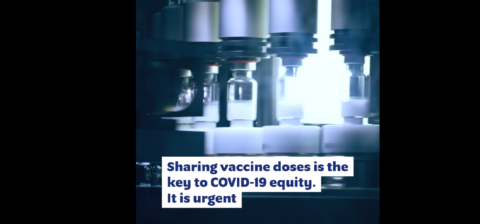Developing COVID-19 vaccines in less than a year was a monumental achievement – but to improve the efficacy, manufacture and distribution of vaccines and combat emerging variants, governments, regulators and research scientists must work together to drive further innovation.
Imagine if scientists invented a COVID-19 vaccine that can be given orally, without the need of a cold chain. Or a simple COVID-19 pill to take as soon as the first symptoms appear. Or imagine future generations facing a pandemic and a vaccine or cure can be developed within 100 days. That might seem far-fetched, but these are things that the biopharmaceutical industry can and should strive for. This is what innovation is about – making the impossible possible.
Without a doubt, developing safe and effective vaccines for the SARS-COV-2 coronavirus was an extraordinary scientific feat. Less than a year after COVID-19 was declared a pandemic, the world has not one, but a range of vaccines approved for emergency use. But biopharmaceutical companies, which are part of a large innovative ecosystem of academics, biotech, generic companies, suppliers of ingredients and contract manufacturers, cannot rest on their laurels.
We should be extremely relieved that, within months of the pandemic being declared, we were able to start building an arsenal of therapies and vaccines. We have seen treatments that have been around for decades (dexamethasone), as well as others that were initially developed to treat the Ebola virus (Remdesivir) or arthritis (Actemra), bring hope to people who have been struck down by COVID-19. In parallel, there are other avenues being explored with monoclonal antibody cocktails, new antivirals and anti-inflammatory antibodies.
There have also been some amazing scientific breakthroughs using new technologies, such as mRNA, applied for the first time to vaccines, protecting the lives of millions. At the same time, we have seen setbacks and companies returning to the drawing board. As the virus continues to evolve, companies continue to pursue their R&D efforts to broaden our set of solutions.
A vibrant vaccines pipeline to keep ahead of the coronavirus
During the past year, no opportunities to move quickly have been missed. But no corners have been cut in making sure the vaccines meet the same rigorous standards as any other biological product. Today, scientists continue to monitor all approved vaccines for safety, and candidate vaccines are being tested through robust clinical trials. Some of these trials are now focussed on specific groups, such as pregnant women or children. For example, Johnson & Johnson plans to begin a study of its single-dose COVID-19 vaccine in children as young as 12 years old by this fall. This will be particularly important as we seek to understand the impact of long COVID on populations, including children, and if they need vaccine protection[1].
Also, we do not know yet how long immunity to the virus lasts, or how effective each vaccine will be against new variants as they emerge. It is important that scientific research and clinical trials continue at pace.
According to the WHO, there are more than 100 candidate vaccines in development. Hopefully, new vaccines in the pipeline, such as the ones from Novovax, Sanofi Pasteur and GSK, or Medicago and GSK, will prove to work.
This ongoing drive for innovation is essential in the fight against COVID-19 and will help:
- Boost immunity: Because both collective and individual immunity to viruses generally weakens over time, booster vaccine shots will play an important role in future immunization strategies.
- Stay ahead of new variants: Viruses also naturally mutate over time, leading to variants against which current vaccines may prove less effective. Both completely new vaccines and booster shots of existing vaccines are now being developed to combat emerging variants. For example, Pfizer and BioNTech are preparing a booster shot specifically to target the highly transmissible delta variant. Moderna is testing whether booster shots can be administered using smaller dosage levels, which would make production both faster and more cost-effective. AstraZeneca announced that the first participants across the UK, South Africa, Brazil and Poland, were vaccinated in a clinical trial to test their updated COVID-19 vaccines for emerging variants[2]. Most vaccine manufacturers expect to have a newly developed booster vaccine ready by the end of 2021.
- Target different variants or diseases: Researchers are also investigating the best way to administer multiple vaccines within a single dose. Pfizer, for example, is exploring a co-administered vaccine that could potentially protect older adults against COVID-19 and pneumonia at the same time[3]. Novavax has announced that its co-administered vaccine, offering protection against COVID-19 and flu, demonstrated positive immune responses in a preclinical study[4]. In a similar way, new COVID-19 vaccines could offer protection against multiple SARS-COV-2 variants within a single, co-administered dose.
- Improve manufacture and delivery: Scientific innovation is not limited to the development of vaccines themselves. New ideas are needed to drive efficiency in manufacturing to compress delivery timelines. Scientific innovation can also make storage and supply cheaper and more efficient. For example, Pfizer and BioNTech are trialling a freeze-dried version of their SARS-COV-2 vaccine that can be stored at room temperature in solid form[5]. These innovations would create significant logistical and economic benefits as vaccines are distributed to populations around the world.
We should not underestimate the amount of research that goes into discovering treatments for COVID-19. Developing effective treatments for COVID will also be crucial to stop the virus in its tracks and lower the risk of hospitals and intensive care units becoming overwhelmed.
Today’s breakthroughs are thanks to years of fostering and enabling innovation
Together with the broader scientific community, the biopharmaceutical industry did not miss a beat in looking to innovation for a solution to COVID-19, and, thankfully, it already had many of the building blocks needed to respond. Recent successes in tackling the pandemic are not one-offs: they come from a long-standing commitment to life-changing innovation, and decades-long investments into cutting-edge medical technologies enabling us to respond swiftly to this crisis.
To continue with such pioneering and wide-ranging vaccine and treatment programs requires the certainty provided to researchers through a clear and consistent framework of public policy and regulation. Intellectual Property (IP) incentives for those spearheading and investing in medical research is also key and will help to cut vaccine development times for COVID-19 while encouraging a speedier response to future pandemics.
IP is also the underlying enabler that has allowed vaccine manufacturers to establish more than 300 collaborations with trusted partners to produce COVID-19 vaccines in historic quantities. Similarly, with treatments, voluntary licenses that depend on the framework provided by IP have been set up with multiple manufacturers around the globe, giving them, in many cases, royalty-free, long-term licenses to manufacture COVID-19 treatments and create supply for both low- and high-income countries.
Sharing samples and data on pathogens
Vaccine developers and the broader scientific community rely on the fast and effective sharing of harmful pathogens and associated information. The first successful vaccines against COVID-19, approved within 326 days from the moment the threat was first identified, could not have been developed with such unprecedented speed had the disease epidemiology of SARS-COV-2 not been made quickly available to everyone trying to conduct research. Indeed, it took little more than a week from the first report of the COVID-19 pandemic for the WHO to confirm the existence of the new coronavirus and for Chinese scientists to publish its genetic sequence.
The COVID-19 pandemic has demonstrated that pathogens know no borders and pose a common global threat to all countries and to all people around the world. When fighting infectious diseases, we need to share pathogens and their genetic information quickly to scientists around the world. This is critical because:
- Diseases need to be tracked, new variants need to be identified and we need to predict how diseases spread;
- Scientists and other experts around the world need to start working together to rapidly develop medical countermeasures such as vaccines, medicines and diagnostics.
Only through the swift and comprehensive sharing of information about the pathogen can scientists around the world ensure that vaccines and treatments are well-matched to the latest variants and are developed, manufactured and supplied in the most effective way possible.
Looking ahead to get better prepared for future pandemics
The world is still grappling with COVID-19, but we also need to look ahead at how we can all be better prepared for the future. We learned and are still learning a lot from our successes and failures. However, much we would like to think we are over the worse, there will still be challenges along the way. One thing is for sure, the biopharmaceutical industry is committed to playing its part to help the world through this pandemic and it will, of course, step up to respond to future pandemics.
In June, we announced our support for the goals of the “100 Day Mission” set by stakeholders, including the G7 and CEPI, to develop a plan to deploy high-quality diagnostics, therapeutics, vaccines and treatments in just 100 days after a new pandemic threat is identified. Slashing the time to 100 days to develop and deploy new countermeasures for future pandemic threats is a very ambitious target. But everything from Polio to HIV to Ebola to COVID-19 seemed at times unbeatable. But science and innovation always find a way to do what was once impossible.
[1] https://www.jnj.com/johnson-johnson-expands-phase-2a-clinical-trial-of-covid-19-vaccine-candidate-to-include-adolescents
[2] https://www.astrazeneca.com/media-centre/press-releases/2021/first-covid-19-variant-vaccine-azd2816-phase-ii-iii-trial-participants-vaccinated.html
[3] https://www.pfizer.com/news/press-release/press-release-detail/pfizer-initiates-study-exploring-coadministration-its-20
[4] https://www.medrxiv.org/content/10.1101/2021.06.09.21258556v1.full
[5] https://www.clinicaltrials.gov/ct2/show/study/NCT04816669?term=Pfizer&cond=SARS-CoV-2&draw=2













